Evidence for specialized rhythm-generating mechanisms in the adult mammalian spinal cord
- PMID: 20484648
- PMCID: PMC6632641
- DOI: 10.1523/JNEUROSCI.0450-10.2010
Evidence for specialized rhythm-generating mechanisms in the adult mammalian spinal cord
Abstract
Locomotion and scratch are characterized by alternation of flexion and extension phases within one hindlimb, which are mediated by rhythm-generating circuitry within the spinal cord. By definition, the rhythm generator controls cycle period, phase durations, and phase transitions. The aim was to determine whether rhythm-generating mechanisms for locomotion and scratch are similar in adult decerebrate cats. The regulation of cycle period during fictive scratching was evaluated, as were the effects of specific sensory inputs on phase durations and transitions during spontaneous fictive locomotion and pinna-evoked fictive scratching. Results show that cycle period during fictive scratching varied predominantly with flexion phase duration, contrary to spontaneous fictive locomotion, where cycle period varied with extension phase duration. Ankle dorsiflexion greatly increased extension phase duration and cycle period during fictive locomotion but did not alter cycle period during scratching. Moreover, stimulating the plantaris (ankle extensor muscle) nerve during flexion reset the locomotor rhythm to extension but not the scratch rhythm. Stimulating the plantaris nerve during extension prolonged the extension phase and cycle period during fictive locomotion but not during fictive scratching. Stimulating the sartorius nerve (hip flexor muscle) during early flexion reduced the flexion phase and cycle period during fictive locomotion, but considerably prolonged the flexion phase and cycle period during fictive scratching. These data indicate that cycle period, phase durations, and phase transitions are not regulated similarly during fictive locomotion and scratching, with or without sensory inputs, providing evidence for specialized rhythm-generating mechanisms within the adult mammalian spinal cord.
Figures


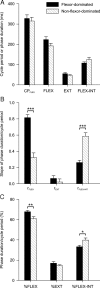
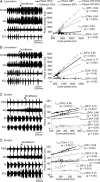
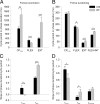
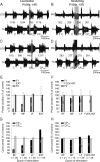
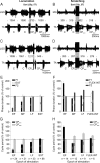
Similar articles
-
Chapter 2--the spinal generation of phases and cycle duration.Prog Brain Res. 2011;188:15-29. doi: 10.1016/B978-0-444-53825-3.00007-3. Prog Brain Res. 2011. PMID: 21333800 Review.
-
Effects of ankle and hip muscle afferent inputs on rhythm generation during fictive locomotion.J Neurophysiol. 2010 Mar;103(3):1591-605. doi: 10.1152/jn.01028.2009. Epub 2010 Jan 20. J Neurophysiol. 2010. PMID: 20089809
-
Parallel reflex pathways from flexor muscle afferents evoking resetting and flexion enhancement during fictive locomotion and scratch in the cat.J Physiol. 2005 Nov 15;569(Pt 1):275-90. doi: 10.1113/jphysiol.2005.095505. Epub 2005 Sep 1. J Physiol. 2005. PMID: 16141269 Free PMC article.
-
Modulation of oligosynaptic cutaneous and muscle afferent reflex pathways during fictive locomotion and scratching in the cat.J Neurophysiol. 1998 Jan;79(1):447-63. doi: 10.1152/jn.1998.79.1.447. J Neurophysiol. 1998. PMID: 9425213
-
Spinal circuitry of sensorimotor control of locomotion.J Physiol. 2001 May 15;533(Pt 1):41-50. doi: 10.1111/j.1469-7793.2001.0041b.x. J Physiol. 2001. PMID: 11351011 Free PMC article. Review.
Cited by
-
Independent control of presynaptic inhibition by reticulospinal and sensory inputs at rest and during rhythmic activities in the cat.J Neurosci. 2013 May 1;33(18):8055-67. doi: 10.1523/JNEUROSCI.2911-12.2013. J Neurosci. 2013. PMID: 23637195 Free PMC article.
-
Physiological, morphological and neurochemical characterization of neurons modulated by movement.J Vis Exp. 2011 Apr 21;(50):2650. doi: 10.3791/2650. J Vis Exp. 2011. PMID: 21540820 Free PMC article.
-
Learning about time within the spinal cord: evidence that spinal neurons can abstract and store an index of regularity.Front Behav Neurosci. 2015 Oct 21;9:274. doi: 10.3389/fnbeh.2015.00274. eCollection 2015. Front Behav Neurosci. 2015. PMID: 26539090 Free PMC article.
-
Hind limb motoneurons activity during fictive locomotion or scratching induced by pinna stimulation, serotonin, or glutamic acid in brain cortex-ablated cats.Physiol Rep. 2017 Sep;5(18):e13458. doi: 10.14814/phy2.13458. Epub 2017 Sep 27. Physiol Rep. 2017. PMID: 28963128 Free PMC article.
-
Cutaneous inputs from the back abolish locomotor-like activity and reduce spastic-like activity in the adult cat following complete spinal cord injury.Exp Neurol. 2012 Jun;235(2):588-98. doi: 10.1016/j.expneurol.2012.03.013. Epub 2012 Apr 1. Exp Neurol. 2012. PMID: 22487200 Free PMC article.
References
-
- Baev KV, Kostyuk PG. Primary afferent depolarization evoked by the activity of spinal scratching generator. Neuroscience. 1981;6:205–215. - PubMed
-
- Baev KV, Esipenko VB, Shimansky YP. Afferent control of central pattern generators: experimental analysis of scratching in the decerebrate cat. Neuroscience. 1991;40:239–256. - PubMed
-
- Bayev KV. Central locomotor program for the cat's hindlimb. Neuroscience. 1978;3:1081–1092. - PubMed
-
- Berkinblit MB, Deliagina TG, Feldman AG, Gelfand IM, Orlovsky GN. Generation of scratching. 1. Activity of spinal interneurons during scratching. J Neurophysiol. 1978a;41:1040–1057. - PubMed
-
- Berkinblit MB, Deliagina TG, Feldman AG, Gelfand IM, Orlovsky GN. Generation of scratching. II. Nonregular regimes of generation. J Neurophysiol. 1978b;41:1058–1069. - PubMed
Publication types
MeSH terms
Grants and funding
LinkOut - more resources
Full Text Sources
Miscellaneous
